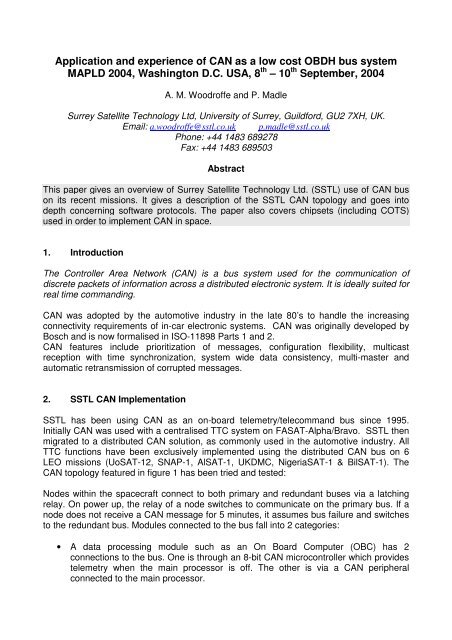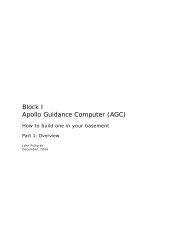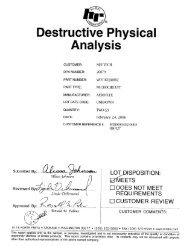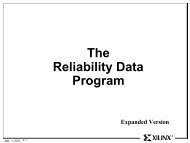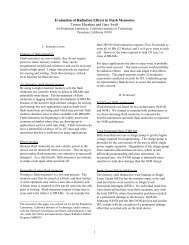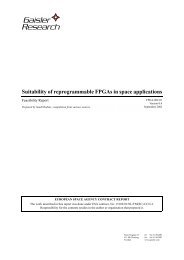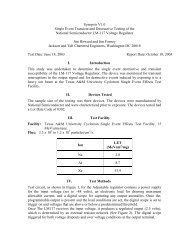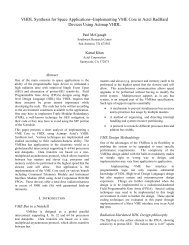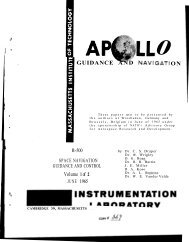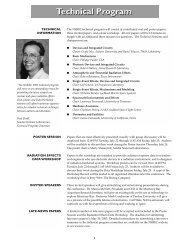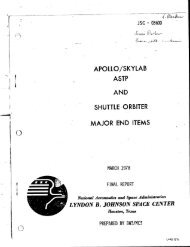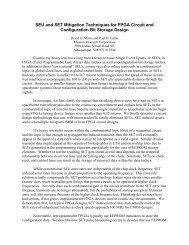Application and experience of CAN as a low cost OBDH bus system ...
Application and experience of CAN as a low cost OBDH bus system ...
Application and experience of CAN as a low cost OBDH bus system ...
Create successful ePaper yourself
Turn your PDF publications into a flip-book with our unique Google optimized e-Paper software.
<strong>Application</strong> <strong>and</strong> <strong>experience</strong> <strong>of</strong> <strong>CAN</strong> <strong>as</strong> a <strong>low</strong> <strong>cost</strong> <strong>OBDH</strong> <strong>bus</strong> <strong>system</strong><br />
MAPLD 2004, W<strong>as</strong>hington D.C. USA, 8 th – 10 th September, 2004<br />
A. M. Woodr<strong>of</strong>fe <strong>and</strong> P. Madle<br />
Surrey Satellite Technology Ltd, University <strong>of</strong> Surrey, Guildford, GU2 7XH, UK.<br />
Email: a.woodr<strong>of</strong>fe@sstl.co.uk p.madle@sstl.co.uk<br />
Phone: +44 1483 689278<br />
Fax: +44 1483 689503<br />
Abstract<br />
This paper gives an overview <strong>of</strong> Surrey Satellite Technology Ltd. (SSTL) use <strong>of</strong> <strong>CAN</strong> <strong>bus</strong><br />
on its recent missions. It gives a description <strong>of</strong> the SSTL <strong>CAN</strong> topology <strong>and</strong> goes into<br />
depth concerning s<strong>of</strong>tware protocols. The paper also covers chipsets (including COTS)<br />
used in order to implement <strong>CAN</strong> in space.<br />
1. Introduction<br />
The Controller Area Network (<strong>CAN</strong>) is a <strong>bus</strong> <strong>system</strong> used for the communication <strong>of</strong><br />
discrete packets <strong>of</strong> information across a distributed electronic <strong>system</strong>. It is ideally suited for<br />
real time comm<strong>and</strong>ing.<br />
<strong>CAN</strong> w<strong>as</strong> adopted by the automotive industry in the late 80’s to h<strong>and</strong>le the incre<strong>as</strong>ing<br />
connectivity requirements <strong>of</strong> in-car electronic <strong>system</strong>s. <strong>CAN</strong> w<strong>as</strong> originally developed by<br />
Bosch <strong>and</strong> is now formalised in ISO-11898 Parts 1 <strong>and</strong> 2.<br />
<strong>CAN</strong> features include prioritization <strong>of</strong> messages, configuration flexibility, multic<strong>as</strong>t<br />
reception with time synchronization, <strong>system</strong> wide data consistency, multi-m<strong>as</strong>ter <strong>and</strong><br />
automatic retransmission <strong>of</strong> corrupted messages.<br />
2. SSTL <strong>CAN</strong> Implementation<br />
SSTL h<strong>as</strong> been using <strong>CAN</strong> <strong>as</strong> an on-board telemetry/telecomm<strong>and</strong> <strong>bus</strong> since 1995.<br />
Initially <strong>CAN</strong> w<strong>as</strong> used with a centralised TTC <strong>system</strong> on FASAT-Alpha/Bravo. SSTL then<br />
migrated to a distributed <strong>CAN</strong> solution, <strong>as</strong> commonly used in the automotive industry. All<br />
TTC functions have been exclusively implemented using the distributed <strong>CAN</strong> <strong>bus</strong> on 6<br />
LEO missions (UoSAT-12, SNAP-1, AlSAT-1, UKDMC, NigeriaSAT-1 & BilSAT-1). The<br />
<strong>CAN</strong> topology featured in figure 1 h<strong>as</strong> been tried <strong>and</strong> tested:<br />
Nodes within the spacecraft connect to both primary <strong>and</strong> redundant <strong>bus</strong>es via a latching<br />
relay. On power up, the relay <strong>of</strong> a node switches to communicate on the primary <strong>bus</strong>. If a<br />
node does not receive a <strong>CAN</strong> message for 5 minutes, it <strong>as</strong>sumes <strong>bus</strong> failure <strong>and</strong> switches<br />
to the redundant <strong>bus</strong>. Modules connected to the <strong>bus</strong> fall into 2 categories:<br />
• A data processing module such <strong>as</strong> an On Board Computer (OBC) h<strong>as</strong> 2<br />
connections to the <strong>bus</strong>. One is through an 8-bit <strong>CAN</strong> microcontroller which provides<br />
telemetry when the main processor is <strong>of</strong>f. The other is via a <strong>CAN</strong> peripheral<br />
connected to the main processor.
• Less intelligent modules are connected to the <strong>bus</strong> via the 8-bit microcontroller which<br />
performs all the control/telemetry gathering needed.<br />
SECONDARY <strong>CAN</strong> BUS<br />
PRIMARY <strong>CAN</strong> BUS<br />
TEMP<br />
DRIVER<br />
<strong>CAN</strong> uC<br />
TC TLM<br />
TYPICAL MODULE<br />
TEMP<br />
Figure 1 – <strong>CAN</strong> Bus Architecture<br />
This architecture ensures the survival <strong>of</strong> the mission upon a single hardware failure<br />
anywhere in the <strong>system</strong>. Failures <strong>of</strong> the transceivers <strong>and</strong> other <strong>CAN</strong> interface hardware<br />
are accounted for by incorporating complete hardware redundancy.<br />
2.1 <strong>CAN</strong> SU Protocol<br />
DRIVER<br />
<strong>CAN</strong> uC<br />
TC TLM<br />
TYPICAL MODULE<br />
SSTL h<strong>as</strong> developed its own relatively simple higher layer protocol on top <strong>of</strong> <strong>CAN</strong>. <strong>CAN</strong> for<br />
spacecraft usage (<strong>CAN</strong>-SU) forces peer to peer addressing <strong>and</strong> is optimised for telemetry,<br />
telecomm<strong>and</strong> <strong>and</strong> buffer transfer. The development <strong>of</strong> <strong>CAN</strong>-SU w<strong>as</strong> driven by SSTL<br />
practices <strong>and</strong> had the fol<strong>low</strong>ing requirements:<br />
• Repeat build <strong>of</strong> spacecraft sub-<strong>system</strong>s for different missions<br />
• Large volume <strong>of</strong> telemetry available<br />
• Scalable platforms<br />
TEMP<br />
At the time <strong>of</strong> <strong>CAN</strong>-SU’s creation, 29 bit <strong>CAN</strong> identifiers were being introduced <strong>and</strong><br />
therefore it is limited to an 11 bit identifier. This h<strong>as</strong> proven to be a limiting factor to the<br />
way the <strong>CAN</strong> is used on SSTL spacecraft.<br />
The <strong>CAN</strong>-SU protocol splits a <strong>CAN</strong> frame up in the fol<strong>low</strong>ing way (with the exception <strong>of</strong> the<br />
buffer transfer) <strong>as</strong> shown in Figure 2 be<strong>low</strong>.<br />
DRIVER<br />
<strong>CAN</strong> uC<br />
TC TLM<br />
TYPICAL DATA<br />
PROCESSING MODULE<br />
DRIVER<br />
<strong>CAN</strong><br />
Periph<br />
uP<br />
TEMP<br />
DRIVER<br />
<strong>CAN</strong> uC<br />
TC TLM<br />
TYPICAL DATA<br />
PROCESSING MODULE<br />
DRIVER<br />
<strong>CAN</strong><br />
Periph<br />
uP
ID (8 bits) Seq = 0 Len<br />
Seq (3 From ID<br />
ID (8 bits) Len Address Address (10bits) (10bits)<br />
bits = 7 (8 (8 bits)<br />
Where:<br />
Figure 2 – <strong>CAN</strong>-SU protocol in a <strong>CAN</strong> frame<br />
Unused<br />
5 bits<br />
11 bit <strong>CAN</strong> Identifier<br />
<strong>CAN</strong> Length<br />
<strong>CAN</strong> Data<br />
Response<br />
Data<br />
32 bits<br />
The 11 bit <strong>CAN</strong> identifier field is split into 2 parts. The first part is the ID <strong>of</strong> a t<strong>as</strong>k running<br />
on a processor (eg AOCS t<strong>as</strong>k), the other being a sequence number that is used in the<br />
buffer transfers. Since the <strong>CAN</strong>-SU identifier field is only 8 bits long, the maximum number<br />
<strong>of</strong> addressable processes in the <strong>system</strong> is 256. Not wanting to limit the amount <strong>of</strong><br />
telemetry channels on the spacecraft to 256 the decision w<strong>as</strong> made to use the <strong>CAN</strong> data<br />
field to hold an address field. This specifies a telemetry/telecomm<strong>and</strong> channel giving a<br />
total <strong>of</strong> 256*2 10 possible telemetry channels across the spacecraft <strong>and</strong> 2 10 channels per<br />
t<strong>as</strong>k. Since the addressing <strong>of</strong> telemetry <strong>and</strong> telecomm<strong>and</strong>s across the <strong>CAN</strong> uses not only<br />
the <strong>CAN</strong> ID field but also part <strong>of</strong> the <strong>CAN</strong> Data field, the use <strong>of</strong> remote frames2 is not<br />
possible. <strong>CAN</strong>-SU therefore only makes use <strong>of</strong> <strong>CAN</strong> Data frames2.<br />
The protocol forces peer to peer addressing by featuring the “From ID” in the <strong>CAN</strong> data<br />
field, this al<strong>low</strong>s the receiving node to know where to acknowledge the request.<br />
The “C” field specifies the <strong>CAN</strong>-SU message type (eg. telemetry request, telemetry<br />
response etc). It is excluded in some packets <strong>of</strong> a buffer transfer in order to maximise data<br />
throughput. The packet type is then determined by the sequence number within the <strong>CAN</strong><br />
ID field. The protocol features several message types some <strong>of</strong> which are detailed in the<br />
fol<strong>low</strong>ing sections.
2.1.1 Telecomm<strong>and</strong> Exchange<br />
Request Source Request Sink<br />
Telecomm<strong>and</strong> request<br />
Telecomm<strong>and</strong> ack<br />
Figure 3 – Example <strong>of</strong> <strong>CAN</strong>-SU Telecomm<strong>and</strong> Exchange<br />
The telecomm<strong>and</strong> exchange (Figure 3) is a simple request/acknowledge transfer using the<br />
<strong>CAN</strong> Data frame2 message format. Since the address <strong>of</strong> the telecomm<strong>and</strong> is comprised <strong>of</strong><br />
both the ID field <strong>and</strong> the address in the data field <strong>and</strong> that a processor t<strong>as</strong>k typically uses 1<br />
ID, overruns <strong>of</strong> the receiving hardware buffer can occur, therefore an acknowledgement<br />
message is necessary. The data field <strong>of</strong> the telecomm<strong>and</strong> request comprises <strong>of</strong> an<br />
address <strong>and</strong> the data or argument related to that telecomm<strong>and</strong> address. The telecomm<strong>and</strong><br />
acknowledgement includes a response field featuring any necessary data response.<br />
2.1.2 Telemetry Exchange<br />
The exchange <strong>of</strong> telemetry is illustrated <strong>as</strong> shown in the fol<strong>low</strong>ing diagram:<br />
Data Sink Data Source<br />
Telemetry request<br />
Telemetry response<br />
ID (8 bits) Seq = 0 Len<br />
ID (8 bits) Seq = 0<br />
= 7<br />
Len<br />
= 7<br />
ID (8 bits) Seq = 0 Len<br />
ID (8 bits) Seq = 0<br />
= 7<br />
Len<br />
= 7<br />
ID (8 bits) Seq = 0 Len<br />
ID (8 bits) Seq = 0<br />
= 3<br />
Len<br />
= 3<br />
ID (8 bits) Seq = 0 Len<br />
ID (8 bits) Seq = 0<br />
= 7<br />
Len<br />
= 7<br />
Figure 4 – Example <strong>of</strong> <strong>CAN</strong>-SU Telemetry Exchange<br />
Telecomm<strong>and</strong> request<br />
From<br />
Unused Data<br />
Address (10bits)<br />
(8 bits)<br />
6 bits 32 bits<br />
Telecomm<strong>and</strong> ack<br />
From<br />
Unused V<br />
Address (10bits)<br />
(8 bits)<br />
5 bits 1 bit<br />
Telemetry request<br />
From<br />
Unused Tlm Seq<br />
Address (10bits)<br />
(8 bits)<br />
5 bits 1 bit<br />
Telemetry response<br />
Response<br />
32 bits<br />
From<br />
Unused Tlm Fmt Tlm Seq Data<br />
Address (10bits)<br />
(8 bits)<br />
4 bits 1 bit 1 bit 32 bits<br />
Telemetry is retrieved using a simple request/response method (Figure 4). Once again<br />
using <strong>CAN</strong> Data frames2, the request packet features a 10 bit address <strong>and</strong> the response<br />
features up to 32 bits <strong>of</strong> data.
2.1.3 Buffer transfer<br />
<strong>CAN</strong> h<strong>as</strong> a small data payload per packet (8 bytes max) which minimises <strong>bus</strong> latency.<br />
Therefore, it is not well suited to large data exchanges between nodes. Therefore, <strong>CAN</strong>-<br />
SU incorporates a buffer transfer scheme that speeds up large data transfers. This is<br />
illustrated be<strong>low</strong>:<br />
Get<br />
Get OK<br />
Burst Request<br />
Start Burst<br />
Burst<br />
Burst<br />
Burst<br />
Burst Request<br />
Start Burst<br />
Burst<br />
Burst<br />
Burst<br />
Done<br />
Done OK<br />
ID (8 bits) Seq = 0 Len<br />
ID (8 bits) Seq = 0<br />
= 7<br />
Len<br />
= 8<br />
ID (8 bits) Seq = 0 Len<br />
ID (8 bits) Seq = 0<br />
= 7<br />
Len<br />
= 8<br />
ID (8 bits) Seq = 0 Len<br />
ID (8 bits) Seq = 0<br />
= 7<br />
Len<br />
= 3<br />
ID (8 bits) Seq = 0 Len<br />
ID (8 bits) Seq = 1<br />
= 7<br />
Len<br />
= 8<br />
ID (8 bits) Seq = 0 Len<br />
Seq = Len<br />
ID (8 bits)<br />
2 to 7 = 78<br />
ID (8 bits) Seq = 0 Len<br />
ID (8 bits) Seq = 0<br />
= 7<br />
Len<br />
= 2<br />
ID (8 bits) Seq = 0 Len<br />
ID (8 bits) Seq = 0<br />
= 7<br />
Len<br />
= 2<br />
Figure 5 – Example <strong>of</strong> <strong>CAN</strong>-SU Buffer Transfer<br />
The transfer is initiated by either a put or a get request to/from the data source. This is<br />
acknowledged by the corresponding sink/source. The get request features a 24 bit buffer<br />
identifier <strong>and</strong> a 24 bit length. Next in the transfer is the burst request. This features the<br />
window size (number <strong>of</strong> packets in a burst). This packet also features the 1 bit “Br” burst<br />
number used to keep sync <strong>of</strong> the bursts (in the “X” byte). The burst features a start burst<br />
<strong>and</strong> up to 6 burst packets. A burst packet features 7 bytes <strong>of</strong> data <strong>and</strong> the from identifier.<br />
After <strong>as</strong> many bursts are transferred <strong>as</strong> are necessary for the transfer, the session is<br />
terminated by a Done <strong>and</strong> Done OK h<strong>and</strong>shake.<br />
From<br />
(8 bits)<br />
From<br />
(8 bits)<br />
From<br />
(8 bits)<br />
From<br />
(8 bits)<br />
From<br />
(8 bits)<br />
C = 0<br />
C = 2<br />
C = 5<br />
X (1 byte)<br />
From<br />
Address C = (10bits) 6<br />
(8 bits)<br />
From<br />
Address C = (10bits) 7<br />
(8 bits)<br />
IUnused L<br />
24 bits 24 bits<br />
IUnused L<br />
24 bits 24 bits<br />
Br Window<br />
=0 size (3 bits)<br />
Reserved<br />
4 bits<br />
Data (6 bytes)<br />
Data (7 bytes)<br />
Done message<br />
Done OK<br />
message<br />
Get message<br />
Get OK<br />
message<br />
Burst Request<br />
message<br />
Start Burst<br />
message<br />
Burst message
2.2 <strong>CAN</strong> Hardware<br />
2.2.1 COTS <strong>CAN</strong> Solution<br />
SSTL specialise in providing <strong>low</strong> <strong>cost</strong>, predominantly LEO missions to a variety <strong>of</strong> civil <strong>and</strong><br />
military markets. It h<strong>as</strong> been the ongoing philosophy to fly exclusively commercial <strong>of</strong>f the<br />
shelf technology (COTS) while mitigating the risk <strong>of</strong> radiation effects by module level<br />
redundancy <strong>and</strong> p<strong>as</strong>sive fail-safe <strong>system</strong> design. This is possible <strong>as</strong> the LEO orbits used<br />
range between 600Km <strong>and</strong> 1000Km where the radiation effects are relatively benign.<br />
The total ionising radiation dose is in the region <strong>of</strong> 1Krad per year (at the component level<br />
with 5mm <strong>of</strong> aluminium shielding), SEUs occur at a rate <strong>of</strong> approximately 1 SEU per Mbyte<br />
<strong>of</strong> SRAM per day (from empirical observations) <strong>and</strong> observed SEL events are very rare,<br />
with only 3 or 4 suspected c<strong>as</strong>es in SSTL’s history.<br />
It h<strong>as</strong> been found that almost all CMOS COTS electronics will survive 10Krads with no<br />
significant degradation in performance. SELs are mitigated by over current trips on the<br />
power <strong>system</strong> <strong>and</strong> cold redundant modules. And SEUs are mitigated by EDAC where<br />
possible. Further SEU protection provided by the design <strong>of</strong> the satellite <strong>system</strong> to be safe<br />
should the on-board computer cr<strong>as</strong>h. For example, the thermal control is p<strong>as</strong>sive <strong>and</strong> will<br />
work with the satellite in any attitude.<br />
The use <strong>of</strong> COTS components al<strong>low</strong>s SSTL to rapidly utilise new technology <strong>as</strong> it enters to<br />
commercial market. SSTL first flew <strong>CAN</strong> <strong>bus</strong> technology in 1996 <strong>and</strong> now uses <strong>CAN</strong> <strong>as</strong><br />
the telemetry <strong>and</strong> tele-comm<strong>and</strong> <strong>bus</strong> for all missions. See table 1 for components f<strong>low</strong>n:<br />
Components f<strong>low</strong>n<br />
Number <strong>of</strong><br />
Missions F<strong>low</strong>n<br />
Philips <strong>CAN</strong> Transceiver: Physical <strong>CAN</strong> driver, current production 4<br />
Phillips PCA82C250: Physical <strong>CAN</strong> driver, going obsolete 10<br />
Philips P87C592: <strong>CAN</strong> microcontroller, obsolete 10<br />
Philips <strong>CAN</strong> 8-bit peripheral, current production 4<br />
Philips PCA82C200: <strong>CAN</strong> 8-bit peripheral, obsolete 6<br />
Infineon: 8-bit <strong>CAN</strong> microcontroller (A/D, PWM etc. 8051), current<br />
production<br />
Microchip <strong>CAN</strong> SPI peripheral 4<br />
Table 1 – COTS <strong>CAN</strong> components used on recent missions<br />
Total numbers <strong>of</strong> a COTS component f<strong>low</strong>n can be substantial. For example, the 8-bit<br />
microcontroller is used on all 30 to 40 modules in a spacecraft, so over the five year<br />
lifetime <strong>of</strong> a typical SSTL satellite, several hundred orbit-years <strong>of</strong> use is collected. This<br />
rapid accumulation <strong>of</strong> failure-free orbit years suggests that COTS is a viable approach to<br />
benign LEO missions.<br />
6
2.2.2 Radiation Tolerant <strong>CAN</strong> Solution (Rad<strong>CAN</strong>)<br />
Recently SSTL h<strong>as</strong> started moving out <strong>of</strong> the benign environment LEO missions. As part<br />
<strong>of</strong> the British National Space Centre funding, a small GEO platform program is being<br />
developed under the project GEMINI. In order to meet the tougher radiation environment<br />
<strong>and</strong> higher reliability (<strong>as</strong> GEMINI h<strong>as</strong> deployable panels <strong>and</strong> therefore no p<strong>as</strong>sive fail-safe<br />
attitude) A COTS approach is no longer applicable <strong>and</strong> a more traditional space industry<br />
solution w<strong>as</strong> required.<br />
As SSTL h<strong>as</strong> a lot <strong>of</strong> <strong>experience</strong> with the <strong>CAN</strong> <strong>bus</strong>, it w<strong>as</strong> decide to develop a Radiation<br />
tolerant <strong>CAN</strong> node – Rad<strong>CAN</strong>. This w<strong>as</strong> to al<strong>low</strong> quicker migration <strong>of</strong> current designs<br />
between the various environments <strong>as</strong> required.<br />
Therefore, the single chip <strong>CAN</strong> microcontroller functionality had to be re-created with a<br />
discrete 8051 microcontroller, memory, EPROM, ADC <strong>and</strong> FPGA, <strong>as</strong> shown in figure 5.1<br />
be<strong>low</strong>.<br />
8051<br />
Boot<br />
EPROM<br />
48 GPIO<br />
FPGA<br />
(208 pin)<br />
CASA2<br />
(<strong>CAN</strong>)<br />
12-bit ADC<br />
Figure 6 – Discrete elements <strong>of</strong> the Rad<strong>CAN</strong> solution<br />
<strong>CAN</strong><br />
Physical<br />
128K x 8<br />
Memory<br />
Relay<br />
Using traditional space approved components a Latch-up immune, highly SEU tolerant,<br />
100Krad solution w<strong>as</strong> produced. However, there is a significant incre<strong>as</strong>e in design<br />
complexity <strong>and</strong> size. The physical impact <strong>of</strong> migrating from COTS to radiation tolerant is<br />
shown in Table 2.<br />
MUX<br />
16 Channels<br />
Primary &<br />
Secondary<br />
<strong>CAN</strong> Bus
COTS microcontroller Rad<strong>CAN</strong><br />
Size 1”sq >6”sq<br />
M<strong>as</strong>s 50g<br />
Power
3 Future Work<br />
3.1 Protocols<br />
<strong>CAN</strong>-SU h<strong>as</strong> been tried <strong>and</strong> tested over a large number <strong>of</strong> missions <strong>and</strong> h<strong>as</strong> been proved<br />
ro<strong>bus</strong>t. It does not however make the most <strong>of</strong> <strong>CAN</strong>. The use <strong>of</strong> 29 bit identifiers could<br />
incre<strong>as</strong>e the amount <strong>of</strong> data available per telemetry request <strong>and</strong> also make use <strong>of</strong> the RTR<br />
bit <strong>and</strong> other features unavailable through <strong>CAN</strong>-SU. Future work on <strong>CAN</strong> protocols at<br />
SSTL could also concentrate on <strong>CAN</strong>Open.<br />
3.2 Hardware<br />
SSTL is currently looking at the latest generation <strong>of</strong> 8-bit microcontrollers to replace the<br />
current infineon device. Initials tests <strong>of</strong> a Microchip PIC device have looked promising with<br />
the 3.3V core providing a significant power saving. The processor can also be clocked up<br />
to 40MHz providing up to 3.5MIPS if required (compared to the infineons 1MIPS).<br />
As SSTL moves out <strong>of</strong> purely LEO missions, the need for more ro<strong>bus</strong>t, radiation tolerant<br />
<strong>system</strong>s incre<strong>as</strong>es. The next generation <strong>of</strong> Rad<strong>CAN</strong> is being developed <strong>as</strong> a System on a<br />
chip solution (SoC), integrating VHDL IP cores for a micro-controller, <strong>CAN</strong> core, memory<br />
<strong>and</strong> EDAC in a single FPGA <strong>as</strong> shown in figure 7. The current FPGA b<strong>as</strong>eline is the<br />
million gate radiation tolerant version <strong>of</strong> the Actel AX.<br />
> 20Kbytes<br />
SRAM from<br />
Internal AX<br />
Resources<br />
16:8 Cyclic<br />
EDAC<br />
SSTL IP Core<br />
Boot Code<br />
Stored <strong>as</strong><br />
LUT<br />
8051<br />
Commercial<br />
IP Core<br />
Figure 7 – IP cores to replace Rad<strong>CAN</strong><br />
Glue<br />
Hurricane<br />
ESA <strong>CAN</strong><br />
IP Core<br />
ADC<br />
Interface<br />
GPIO<br />
& Custom<br />
Interfaces<br />
Actel RTAX1000S<br />
External ADC <strong>and</strong><br />
Analog multiplexers<br />
Are still required<br />
IO can be configured<br />
As LVDS or LVTTL<br />
For applications not requiring microcontroller functionality, Rad<strong>CAN</strong> Lite is being<br />
developed <strong>as</strong> just the <strong>CAN</strong> core with a simple state-machine for telemetry <strong>and</strong><br />
telecomm<strong>and</strong> services. This design would be targeted at the smaller <strong>and</strong> cheaper Actel<br />
RTSXA range <strong>of</strong> FPGAs.
4 Conclusion<br />
With 10’s <strong>of</strong> orbit years <strong>of</strong> use on SSTL satellites, COTS <strong>CAN</strong> h<strong>as</strong> been proven to be a<br />
suitable architecture for the radiation benign LEO missions. The combination <strong>of</strong> module<br />
redundancy <strong>and</strong> fault tolerant <strong>system</strong> design h<strong>as</strong> resulted in no observed failures <strong>of</strong> the<br />
<strong>CAN</strong> <strong>bus</strong> or it’s constituent components.<br />
With the developments outlined above, the <strong>CAN</strong> <strong>bus</strong> will be an attractive alternative to<br />
more traditional space <strong>bus</strong> architecture for all missions.<br />
5 References<br />
1. http://www.caen.it/micro/rd_c<strong>as</strong>ta.html: a Rad-Hard 8051 microcontroller with on chip<br />
<strong>CAN</strong> hardware.<br />
2. http://www.can.bosch.com/: bosch’s <strong>CAN</strong> page<br />
3. http://www.can.bosch.com/docu/can2spec.pdf : the Bosch <strong>CAN</strong> 2.0 B specification<br />
4. http://www.can-cia.org/: <strong>CAN</strong> in automation<br />
5. http://www.vector-informatik.com/canlist/: an informative <strong>CAN</strong> mailing list


